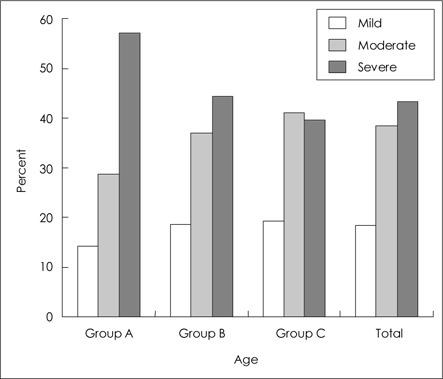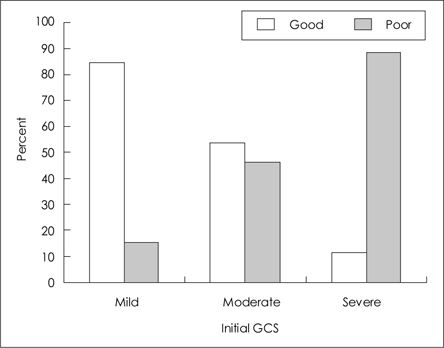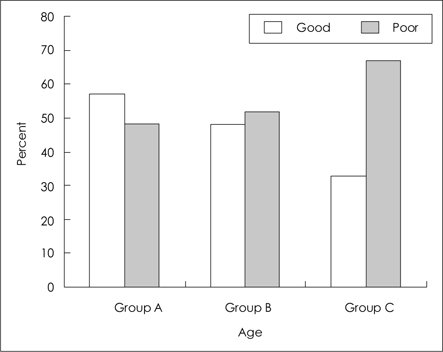J Korean Neurotraumatol Soc.
2009 Jun;5(1):5-10. 10.13004/jknts.2009.5.1.5.
The Analysis of Surgical Results of Traumatic Acute Subdural Hematoma According to Age
- Affiliations
-
- 1Department of Neurosurgery, Wonkwang University College of Medicine, Iksan, Korea. kseom@wonkwang.ac.kr
- KMID: 2019926
- DOI: http://doi.org/10.13004/jknts.2009.5.1.5
Abstract
OBJECTIVE
We aimed to analyze the surgical results of traumatic acute subdural hematoma (ASDH) in relation to the age of the patients and to report our recent experiences in treating such patients.
METHODS
In this retrospective study, we reviewed the case histories of 141 patients with traumatic ASDH, all of whom had undergone surgical evacuation of hematoma in course of a 5-year period. In order to identify the age-dependent clinical characteristics, the patients were divided into 3 groups according to their ages. Group A consisted of 14 patients aged 0-29 years, group B consisted of 54 patients aged 30-59 years, and group C comprised 73 patients aged over 60 years. We analyzed the clinical status, mortality, and outcomes in relation to the ages of the patients.
RESULTS
The overall male-to-female ratio was 3.7:1, and the mean age of the patients was 55.7 years (range, 1-85 years); however, the male-to-female ratio in group B was 12.5:1. The most frequent cause of trauma was vehicular accidents. The overall mortality rate was 29%, group A was 21.3%, group B was 14.8%, and group C was 24.7%. There were no significant differences in the mortality among the three groups. However, mortality rate was significantly increased among the patients aged over 70 years and less than 17 years. The surgical outcomes were significantly influenced by the age and the initial Glasgow coma scale (GCS) scores.
CONCLUSION
Our results show the patient's age was significantly associated with an unfavorable outcome of surgical evacuation of traumatic ASDH. Therefore, we recommend that neurosurgeons should exercise greater caution while considering surgical evacuation in the old-aged group.
Keyword
MeSH Terms
Figure
Reference
-
1. Amacher AL, Bybee DE. Toleration of head injury by the elderly. Neurosurgery. 1987; 20:954–958.
Article2. Baker SP, Harvey AH. Fall injuries in the elderly. Clin Geriatr Med. 1985; 1:501–512.
Article3. Champion HR, Copes WS, Buyer D, Flanagan ME, Bain L, Sacco WJ. Major trauma in geriatric patients. Am J Public Health. 1989; 79:1278–1282.
Article4. Chesnut RM, Marshall LF, Klauber MR, Blunt BA, Baldwin N, Eisenberg HM, et al. The role of secondary brain injury in determining outcome from severe head injury. J Trauma. 1993; 34:216–222.
Article5. Dent DL, Croce MA, Menke PG, Young BH, Hinson MS, Kudsk KA, et al. Prognostic factors after acute subdural hematoma. J Trauma. 1995; 39:36–42. discussion 42-43.
Article6. Ellis GL. Subdural hematoma in the elderly. Emerg Med Clin North Am. 1990; 8:281–294.
Article7. Grant PT, Henry JM, McNaughton GW. The management of elderly blunt trauma victims in Scotland: evidence of ageism? Injury. 2000; 31:519–528.
Article8. Jamjoom A, Nelson R, Stranjalis G, Wood S, Chissell H, Kane N, et al. Outcome following surgical evacuation of traumatic intracranial haematomas in the elderly. Br J Neurosurg. 1992; 6:27–32.
Article9. Jones S, Kafetz K. A prospective study of chronic subdural haematomas in elderly patients. Age Ageing. 1999; 28:519–521.
Article10. Koç RK, Akdemir H, Oktem IS, Meral M, Menkü A. Acute subdural hematoma: outcome and outcome prediction. Neurosurg Rev. 1997; 20:239–244.11. Morris JA Jr, Mackenzie EJ, Damiano AM, Bass SM. Mortality in trauma patients: the interaction between host factors and severity. J Trauma. 1990; 30:1476–1482.12. Mosenthal AC, Lavery RF, Addis M, Kaul S, Ross S, Marburger R, et al. Isolated traumatic brain injury: age is an independent predictor of mortality and early outcome. J Trauma. 2002; 52:907–911.
Article13. Pennings JL, Bachulis BL, Simons CT, Slazinski T. Survival after severe brain injury in the aged. Arch Surg. 1993; 128:787–793. discussion 793-794.
Article14. Santora TA, Schinco MA, Trooskin SZ. Management of trauma in the elderly patient. Surg Clin North Am. 1994; 74:163–186.
Article15. Servadei F. Prognostic factors in severely head injured adult patients with acute subdural haematoma's. Acta Neurochir (Wien). 1997; 139:279–285.
Article16. Woertgen C, Rothoerl RD, Schebesch KM, Albert R. Comparison of craniotomy and craniectomy in patients with acute subdural haematoma. J Clin Neurosci. 2006; 13:718–721.
Article17. Yoon SM, Lee KS, Lee JH, Doh JW, Bae HG, Yun IG. Surgical outcome following evacuation of traumatic intracranial hematomas in the elderly. J Korean Neurosurg Soc. 2003; 33:477–482.
- Full Text Links
- Actions
-
Cited
- CITED
-
- Close
- Share
- Similar articles
-
- Intraoperative Development of Contralateral Subdural Hematoma during Evacuation of Acute Subdural Hematoma: Case Report
- Spontaneously Rapid Resolution of Acute Subdural Hemorrhage with Severe Midline Shift
- Bilateral Acute Subdural Hematoma Following Evacuation of Chronic Subdural Hematoma
- Acute Cervical Subdural Hematoma Following Minor Trauma, with Complete Recovery
- Traumatic Acute Subdural Hematoma: Prognosis and Operative Timing





